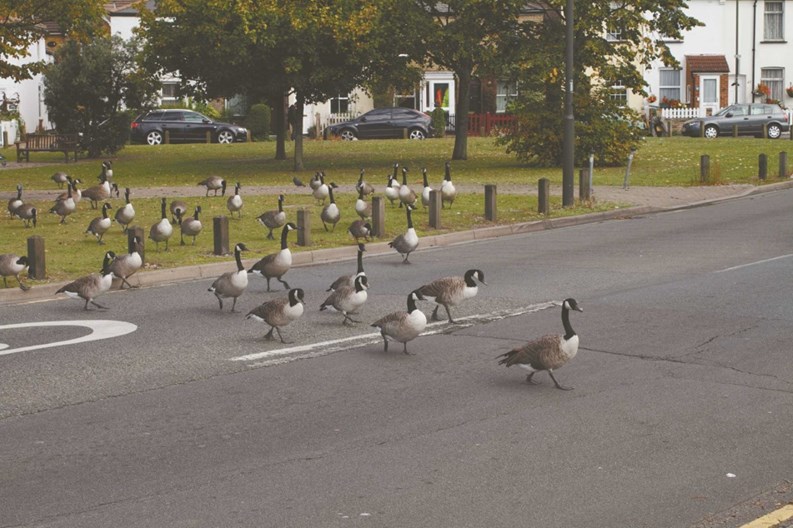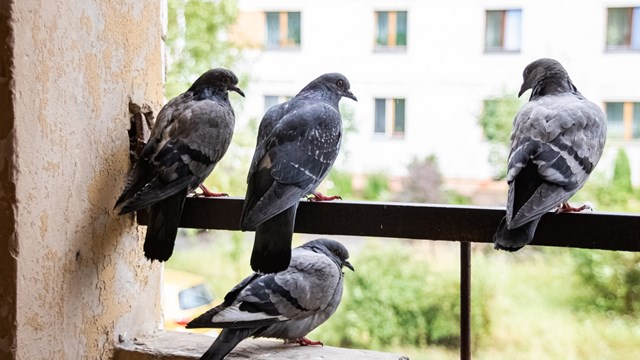Picture it: you wake up early one fine weekend morning and put on your sneakers, looking forward to a bracing run around your HOA's picturesque grounds. Maybe you'll jog around the pond—the turf is nice and flat, and the well-manicured grounds provide a lovely backdrop for your workout. You head out the door, and make your way down the path to the pond. And that's when you see them. Dozens—no, scores—of them. Hunkered down on the path and in the grass like small boulders, blocking your route and giving you the side-eye as you get closer. They're Canada geese—big, territorial, and not at all happy to be disturbed.
And it's not just the birds themselves between you and the pond. Their droppings are literally everywhere you step, befouling your running shoes and turning the whole path into a minefield. As you try to scrape off your shoe, one of the larger birds rises, spreads its enormous wings, and begins to hiss and honk, agitating the others and making you reconsider your workout plans. Maybe today isn't the day to enjoy the pond, or the path, or any of the grounds your association dues pay to maintain.
Canada Geese, Eh?
While city residents must contend with pigeons, and those living on the waterfront have to deal with seagulls, residents of more suburban HOAs often find themselves at odds with geese. Once migratory, these 12- to 15-pound birds have lost much of their rambling instinct over the decades, thanks to well-meaning reintroduction efforts and the proliferation of attractive nesting and congregation spots.
As it happens, many of those ideal spots are man-made. “Geese bother people a lot in condos," says Rebecca Fyffe, a wildlife educator with the Wildlife Control Policy Institute, a national organization based in Chicago. "If a goose could make us do what it wanted us to do in terms of landscaping for its pleasure, it would look like exactly what we do at condo developments. The grass would be cut short, there would be a pond, and there would be no tall plants around the pond. We’re landscaping to attract geese."
And playing host to a few hundred large birds can be more than just a nuisance, say the pros. Resident geese can eat cultivated grass down to a nub, costing thousands in reseeding and sodding fees; they loiter on golf courses, and other green areas, leaving their droppings and feathers everywhere and discouraging residents from using the spaces they're paying for. Birds carry mites, and their droppings are hotbeds of bacteria and parasites that can cause illness in both humans and pets alike. If a flock is large enough, it can even contaminate water supplies. And while it's a blessedly rare occurrence, geese have been known to bring down commercial aircraft by getting sucked into plane engines.
Prevention is Key
So what's to be done? Most wild migratory birds—including geese—are protected under federal law, which can make getting rid of them tricky. "You can't disturb the nest of a protected bird," says Fyffe, "or take their eggs or young away." State laws also vary in terms of what methods can and cannot be used to control avian pests, and violation of licensing and permitting laws can cost tens of thousands of dollars in fines. That's why it's usually best to call in a professional to help deal with a goose invasion. "Whoever you contract with should be a member of the National Pest Management Association," suggests Stuart Aust, president of CEO of Bird Doctor Nationwide in Paramus. "Most members are attending seminars and conferences so they'll be up-to-date on the latest methods."
Avian pest pros agree that ultimately, the key to successful bird control is prevention—and that begins with making your property less attractive to feathered guests. This can be done a lot of different ways, ranging from the very inexpensive to the very pricey. “The more angles you approach it from, the better off you are," says Kim Gurlavich, a wildlife specialist with the U.S. Department of Agriculture’s (USDA) Wildlife Services Program in New Jersey. "Because there’s not one quick fix."
As with any pest, the first step in making your property less hospitable to geese is to stop feeding them. A strongly enforced, association-wide rule outlawing feeding geese—along with a hefty fine to back it up—is a good way to start. After that, an escalating program of harassment tactics can be effective in getting rid of them. Geese don’t like unusual noises or sights, so many HOAs put out shiny or noisy objects like flags, strips of flashy metal or noisemakers to scare them off.
According to Fyffe, another way to make geese uncomfortable is to stretch a wire or other thin filament around the edge of a pond or other water feature that's popular with the birds. Most waterfowl need a 'running start' to get airborne, as well as a lengthy runway for landing, and a wire in the way foils those efforts. Some associations have even used radio-controlled boats to chase birds off the water.
Aust says that among the ways to move geese off the property, people have tried fake dogs, chemical sprays and water sprinklers. They are not long term solutions, he adds, but according to the Humane Society of the United States, there are long-term humane solutions such as population stabilization, which slows down or stops the increase in resident goose population. It uses an oiling system that stops the eggs from development. As a result, no goslings mean the parents and other members of the flock have no reason to stay.
“Rarely does a ‘silver bullet’ or a standalone methodology work best for Canada Geese situations. Rather, two or more of the following recommended methodologies can be ntegrated for control,” Aust says, noting that outdoor sound devices, goose repellents, trained border dogs, dog and coyote decoys, and pyrotechnic devices, are most commonly used.
One popular method is using dogs to what the pros call 'harrassment.' Harassing a flock of geese basically involves annoying them until they leave in a huff—and on land, trained dogs are experts at annoying geese. These dogs (typically border collies or Australian shepherds) bark at and chase the birds, and the geese eventually decide that the property just isn't worth the hassle.
According to Brett Madden, owner of Geese Chasers of North Jersey, “the border collie method is effective because it mimics an arctic fox, a natural known predator of the Canadian geese. With the dog, the geese think it’s not safe for them to be there.”
Madden conducts an initial site inspection and shows the manager a demonstration of what his company does. A company that works with border collies must have special training to work with the dog and, Madden says, a special permit taken out in the name of the owner of the property if there is going to be any handling of the eggs.
Harrier dogs are usually brought to a goose-infested community several times a day, over a period of four to 12 weeks, Madden explains, staying until the border collies chase the geese away.
Unfortunately, harassment tactics share a common failing: geese can adapt. Geese can become accustomed to noise, inured to the presence of shiny mylar flags, or simply return next year after the dogs are gone, says Ron Jones, a wildlife control specialist at Animal Control Products in Monroeville. "We harass the geese but it's not an easy process. You have to be out there several times a day in order to be effective."
Stepping Up the Fight
Along with eliminating food and siccing dogs on encampments of geese, there are more techologically-sophisticated methods as well, including motion-activated water sprayers that squirt birds as they attempt to land, and electrical strips or fencing that can be installed wherever they like to congregate. A very mild electrical charge pulses through the strip every few seconds, irritating birds and strongly encouraging them to seek shelter elsewhere. Also, putting fences around ponds can convince the geese to move elsewhere.
Sound is another weapon in the anti-goose arsenal. Recordings of predator sounds or the cries of birds in distress can be played at intervals to warn others away from the area. High-frequency ultrasonic deterrents are yet another option. These sounds are too high-pitched for a human to hear, but are extremely unpleasant for birds, and can encourage them to move it along.
Another way to drive geese off the property involves the use of chemical repellents, like FlightControl Plus or Methyl Anthranilate (MA), a grape extract, according to Aust. These EPA-approved repellents are applied to a condo’s turf. When geese munch on the treated grass, they get an upset stomach. The repellent also contains a compound that absorbs ultra-violet light, which only geese can see. The birds eventually associate the repellant-treated grass with sickness and move on, seeking food that doesn’t make them queasy. The downside of repellants is that they can be labor-intensive, requiring reapplication after every rainfall.
Humane vs. Nuclear
Using humane, non-leathal means to deter birds is a big concern for folks who love animals—even pesky birds—but who aren't okay with having their property taken over by Mother Nature's squawking or honking hordes. While some suburban communities have taken drastic steps to curb overpopulation by waterfowl such as hunting or euthanizing them, most bird control pros and civilians alike would prefer to get rid of birds by non-lethal means.
“We don’t kill them," says one specialist, "we just chase them out, close up the areas they’re getting into, and let them go find some other spot. There are pest control companies that use poison corn, but I’m against using poison, because it can kill non-targeted birds. Nobody wants to poison the cardinals, blue jays and other birds that feed off corn.”
A more drastic approach to keeping the goose population down is by disrupting their breeding cycle, typically by puncturing their eggs, burying them, or 'addling' them—smearing them with corn oil to prevent hatching. Permits are also required to addle eggs in New Jersey, and while the method is effective,
it's time-consuming, says Gurlavich. Every nest must be located and every egg treated, she says. “You have to constantly go back when they’re nesting to check—because they’ll lay new eggs once [one clutch of] eggs are addled.”
At the far end of the spectrum is of course killing the birds outright. Hunting directly reduces the goose population, though times for hunting geese legally in New Jersey are limited to three short seasons, and many developments have houses too close together to permit safe hunting. In addition, hunters themselves need a variety of licenses, including a New Jersey hunting license.
Even more controversial than hunting geese is the practice of “gassing” them—a method that had been widely used in a number of New Jersey communities over the years. Gassing is usually done during molting season, when geese can’t fly, and involves herding the animals into enclosures where they’re euthanized with toxic chemicals, using guidelines approved by the American Veterinarian Medical Association (AMVA).
According to Maggie Brasted, wildlife policy associate for the Humane Society, gassing them has been widely condemned by the society. “We have issues about the way they’re using this method,” she says. “They are putting geese in big chambers with lots of animals together, and the AVMA standards don’t address that part of it. The main issue is these animals don’t need to be killed. You’re really killing them just because people find them inconvenient.”
These days, with the movement toward using greener, less invasive ways to solve common property problems, there are so many other ways to control pesky birds, killing them rarely even enters the picture. It may take a couple of tries to find what works best for your community, and sometimes a goose problem requires a combination of measures to solve. With patience and ingenuity, however, your HOA won't go to the birds.
Hannah Fons is an associate editor at The New Jersey Cooperator. Massachusetts-based freelance writer Marie Auger contributed to this article.







Leave a Comment